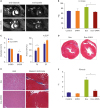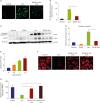INTRODUCTION
METHODS
Chemicals and reagents
Animals
Dox-induced cardiomyopathy experiment
Mouse magnetic resonance imaging
Cell culture and materials
Cytotoxicity assay and adenosine triphosphate assay
Determination of mitochondrial membrane potential and reactive oxygen species
RNA isolation and quantitative real-time reverse transcription polymerase chain reaction
Western blot analysis
Histological analysis
RESULTS
An sodium-glucose co-transporter 2 inhibitor attenuates Dox-induced cardiomyopathy in mice
 | Figure 1The SGLT2 inhibitor protects against Dox-induced cardiac toxicity. (A) Representative images of Dox-mediated changes in cardiac structure and function from cardiac MRI. (B) and (C) The Dox+EMPA group showed reduced LV mass, decreased LVESD, and improved FS compared with the Dox group. (D) Masson's trichrome stained cross-sections of mice, 2 weeks after single Dox injection. (E) Representative images of LV sections stained with H&E and with Masson's trichrome. The Dox+EMPA group showed less myocardial damage. (F) Quantification of interstitial fibrosis. Scale bar=50 μm. Each bar represents mean±standard error of mean.Dox = doxorubicin; EF = ejection fraction; EMPA = empagliflozin; FS = fractional shortening; H&E = hematoxylin and eosin; LV = left ventricle; LVEDD = left ventricular end diastolic diameter; LVESD = left ventricular end systolic diameter; MRI = magnetic resonance imaging; SGLT2 = sodium-glucose co-transporter 2.
*p<0.05.
|
Beta hydroxybutyrate protects against Dox-induced cardiotoxicity in vitro
 | Figure 2The SGLT inhibitor protects cardiomyocytes by increasing βOHB. (A) and (B) Sglt1 and Sglt2 mRNA expression in mouse LV and kidney by qRT-PCR. (C) Representative light microscopic images of H9C2 cells. H9C2 cells were stimulated with 5 μM Dox or pre-treated with PHL or βOHB for 2 hours and then treated with 5 μM Dox for 24 hours. (D) H9C2 cell viability of the PHL pre-treatment group by an MTT assay. (E) H9C2 cell viability of the βOHB pre-treatment group by an MTT assay. βOHB group showed improved cell viability under 1 μM Dox-induced cardiotoxicity compared to non-treated group. Scale bar=50 μm. Each bar represents mean±standard error of mean.βOHB = beta hydroxybutyrate; Dox = doxorubicin; LV = left ventricle; mRNA = messenger RNA; MTT = 3-(4,5-dimethylthiazol-2-yl)-2,5-diphenyltetrazolium bromide; PHL = phloridzin; qRT-PCR = quantitative real-time reverse transcription polymerase chain reaction; SGLT = sodium-glucose co-transporter.
*p<0.05 vs. Dox-treated group.
|
Beta hydroxybutyrate reduces reactive oxygen species and improves mitochondrial function
 | Figure 3βOHB reduces ROS and improves mitochondrial function. (A) Representative confocal fluorescence images of H9C2 cells after Dox treatment. Higher level of ROS was detected by H2DCFDA staining (green fluorescence). (B) Quantification of intracellular ROS levels. βOHB reduced ROS of H9C2 cells with Dox. (C) Representative images of western blotting of cleaved caspase 3 and CHOP. (D) Densitometry analysis of immunoreactive bands of cleaved caspase 3. βOHB reduced cleaved caspase 3 expression of H9C2 cells with Dox. (E) Intracellular ATP was measured using a firefly-based ATP assay kit. Calculated ATP contents were normalized to the total protein content. Data are shown relative to ATP levels of the control (non-treated H9C2 cells). βOHB (1mM) increased ATP production compared to control. (F) Representative confocal fluorescence images of H9C2 cells stained with TMRM fluorescence probe (red fluorescence). (G) Quantification of TMRM fluorescence. βOHB restored TMRM intensity of H9C2 cells with Dox. Scale bar=50 μm. Each bar represents mean±standard error of mean.ATP = adenosine triphosphate; βOHB = beta hydroxybutyrate; CHOP = C/EBP homologous protein; DCF = 2′,7′-dichlorofluorescin; Dox = doxorubicin; H2DCFDA = 2′,7′-dichlorodihydrofluorescein diacetate; ROS = reactive oxygen species; TMRM = tetramethylrhodamine methyl ester.
*p<0.05; †p<0.01.
|
An sodium-glucose co-transporter 2 inhibitor protects the heart by increasing beta hydroxybutyrate levels
 | Figure 4The SGLT2 inhibitor protects the heart by increasing βOHB. (A) Serum βOHB levels of mice, 2 weeks after single Dox (15 mg/kg) or saline injection. EMPA increased Serum βOHB levels of mice in both Control and Dox treated mice. (B) mRNA expression of FoxO3a, Sod2, and Cat (encoding catalase) in LV tissues of mice after single Dox or saline injection. EMPA increased these genes expression in LV tissues of mice with Dox. (C) Representative images of LV sections stained with H&E and with Masson's trichrome. Mice were injected daily with βOHB intraperitoneally after single Dox injection for 14 days. (D) Gross anatomical changes of Dox-treated hearts in a chronic model. (E) Representative images of LV sections stained with H&E and with Masson's trichrome. (F) A proposed model for the cardioprotective effect of the SGLT2 inhibitor against Dox-induced HF. Heart image was obtained and modified from Pixabay 2017 (https://pixabay.com/en/heart-human-heart-anatomy-medicine-2028154). Scale bar=50 μm. Each bar represents mean±standard error of mean.βOHB = beta hydroxybutyrate; Dox = doxorubicin; EMPA = empagliflozin; H&E = hematoxylin and eosin; HF = heart failure; LV = left ventricle; mRNA = messenger RNA; ROS = reactive oxygen species; SGLT2 = sodium-glucose co-transporter 2.
*p<0.05.
|




 PDF
PDF ePub
ePub Citation
Citation Print
Print



 XML Download
XML Download